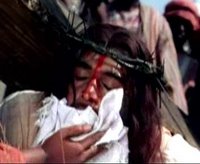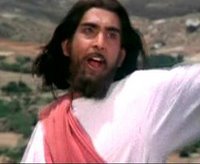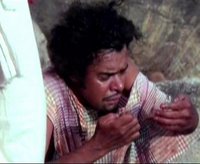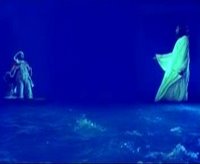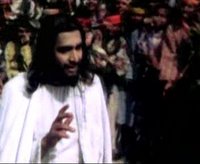
One of the most common criticisms of films about Jesus is that he has never been portrayed by a Jewish actor. In fact the vast majority of pictures made about Christ have starred a white European/North American actor i
n the central role. Some, such as Johnny Cash/Robert Elfstrom's The Gospel Road even portray, an Anglo-Saxon ultra-blond Jesus. There are signs that the tide is turning. This year has seen the release of the first major film to feature a black actor playing Jesus, albeit in a modernised version of the story in Mark Dornford-May's Sundance Festival hit
Son of Man. Hot on its heels is the forthcoming
Color of the Cross.
However, whilst we wait, there is one Jesus film that has, at least, cast an actor from the right continent. Known by many names including
Daya Sagar, Oceans of Mercy, Karunamoorthy, and
Karunamayudu the film is largely unknown in the west and yet has played to 19 million people in thousands of villages in India. The film owes this large audience largely down to missionary organisation
Dayspring International. They claim 7 million have become Christians as a result.
1The film was actually completed by Indian producer Vijay Chandar in 1978, using largely Indian actors. Whilst not technically a Bollywood film (in the way that not all American cinema is technically "Hollywood"), there are clear stylistic similarities to other works of Indian Cinema.
Chandar himself played Jesus, and his portrayal, particularly given depictions of Jesus in American films of the time, is strong. He is believable both when he smiles, and when he is angry. A strong sense of compassion comes across in a number of scenes, without him ever appearing wimpy, or tediously "nice".
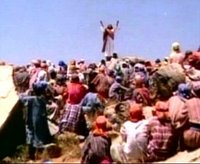
The film also gives him a healthy balance of humanity and divinity. Whilst the film doesn't strive to investigate Jesus's emotions or his inner thoughts, it does portray him as someone who is in touch with the people around him, reacting and interacting with the people around him, rather than being emotionally distant. There are some notable exceptions when we see Jesus teaching high above his audience. However, these scenes are balanced with those of him amongst the people. One of these even starts with him teaching from high up, but stopping his preaching to come down to the bottom of the hill they are on and heal a leper. Across the film, this balance marks Chandar's Jesus out as both a man of the people, and yet still someone who is important and has something to say. He draws people to himself to hear his vital message.
In order to stress the divinity of Jesus, and the supernatural nature of many of the events around him, the film uses a considerable number of special effects. To western viewers these might seem cheaply created, poorly executed and somewhat kitschy, particularly in the days of seamless CGI.

In particular the "dove" that alights on Jesus's head is laugh-out-loud awful. However, whilst they lack the gloss, and the sophistication of American films, their clunky execution emphasises the otherness of these events. They are extra-ordinary. Furthermore, given that this film is not created for western audiences such criticisms, whilst certainly having some validity, are not so problematic for the intended audience. It should be noted as well that many other films about the life of Jesus have either minimised the number of miracles, kept supernatural elements off-screen, or shown them in a more naturalistic style, perhaps relying on cuts.
The other aspect that may seem strange to western viewers are the dance/musical numbers. Whilst singing is hardly alien to the Jesus film genre (
Jesus Christ Superstar, Godspell) those films are predominantly musical. Here however, there are only a couple of such routines. Often in Indian Cinema western viewers find the songs cut completely across the feel of the rest of the movie; The sound is differently produced from the rest of the film, and previously serious and intense characters burst into song and dance.
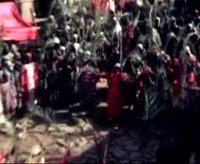
Actually though, this is not the case with
Dayasagar. There are only two song routines which are two of the film's high points. The opening sequence covers Jesus's birth and childhood, with skilful brevity which captures the essentials without bogging the story down in pseudo-piety. The sequence takes only 5-10 minutes, and yet covers all the essential elements of the story. The second song/dance routine covers Jesus's triumphal entry into Jerusalem. This was perhaps the strongest scene in Jewison's
Jesus Christ Superstar (1973), no doubt because of the way the setting of the biblical episode lends itself to a large chorus scene. Here the scene is spectacular. Whilst it could never be argues that this was how it really happened, it captures the feel of that episode wonderfully.
The film also bears comparison with a number of other American Jesus films, in particular
Day of Triumph (1954), and
King of Kings (1961). All three films devote a portion of their runtime to the Zealots, their clashes with Rome, and their plans to use Jesus to further their own aims. Each film also shows Judas associated with the Zealots, yet being initially attracted to Jesus, before ultimately getting disillusioned with the path of peace he is taking and betraying him in the hope it will cause him to rise up. Given that this film was made only around 30 years after a peaceful Indian leader had managed to free his people from the oppression of a foreign empire there must have been a number of strong resonances in these scenes for Indian audiences. It is perhaps no coincidence that the film also challenges the caste system.
So, whilst at times the production values are a far cry from contemporary western cinema,
Dayasagar has much to offer, not least because the gap between its intended/original audience and the events which it depicts are narrower than for any other Jesus film.
2
1 - Joshua Newton - "Blockbuster Evangelism" in Christianity Today - December 2003.
2 - This, of course, does not take into consideration those films which try to bring Jesus up-to-date into a modern western context.
Labels: Dayasagar, Indian Jesus Films
 More than any other film, people ask me how they can get to see Dayasagar (also known as Daya Sagar, Oceans of Mercy, Karunamoorthy, Karunamayudu ). For a while it was available to buy on DVD, but I'm told that this is no longer the case. So I was pleased to hear that the film is now available to view online at wlivetv. Thanks to whoever it was that gave me the tip off.
More than any other film, people ask me how they can get to see Dayasagar (also known as Daya Sagar, Oceans of Mercy, Karunamoorthy, Karunamayudu ). For a while it was available to buy on DVD, but I'm told that this is no longer the case. So I was pleased to hear that the film is now available to view online at wlivetv. Thanks to whoever it was that gave me the tip off.













